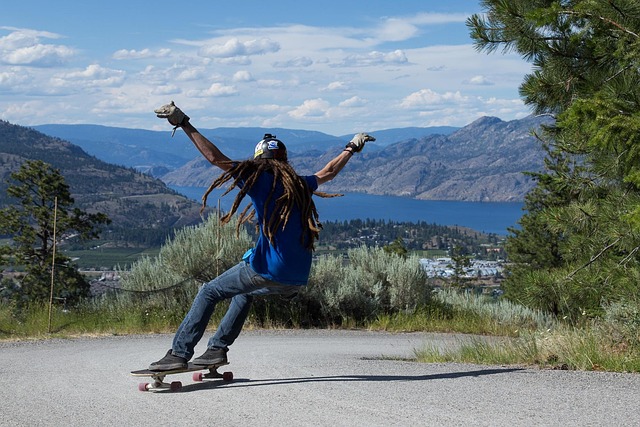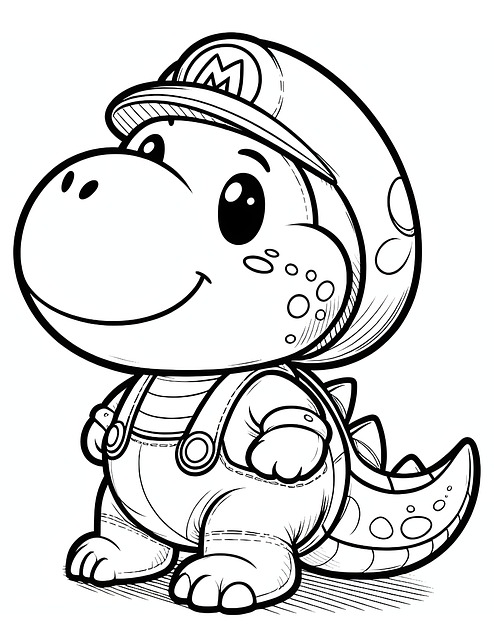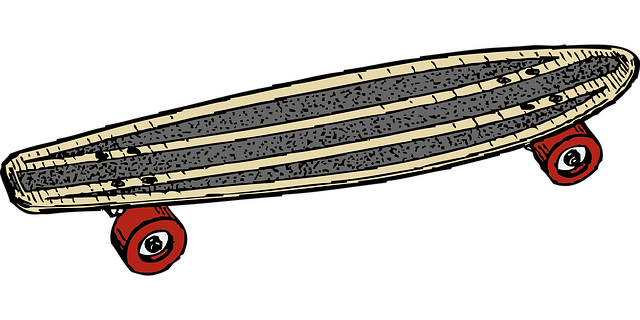Longboard riding offers a unique and thrilling experience accessible to seasoned skaters and newcomers alike. Beginners should focus on smooth turns, speed control, and basic techniques like carving. Choosing the right board with drop-through or pin tail shapes, 70-80mm wheels, durometers between 70A-85A, and symmetric or directional deck shapes is crucial. Prioritize durable construction, wide decks, large wheels with soft rubber, high-quality bearings, and responsive trucks for comfort and control. Mastering basic control skills like carving and turning gradually builds confidence. Safety is paramount; always wear protective gear and be mindful of your surroundings. Regular maintenance extends board lifespan. Embracing diverse riding styles and joining communities fosters growth. Overcoming common challenges through consistent practice and patience builds confidence to explore different terrains.
Planning your first longboard ride? This comprehensive guide is tailored for longboard enthusiasts of all levels. From understanding the basics of longboard riding to mastering advanced techniques, we’ve got you covered. Learn how to choose the perfect board and essential components for a smooth experience. Discover safety measures, maintenance tips, and different riding styles. Overcome challenges and build confidence as you explore this exhilarating sport from a beginner’s perspective.
Understanding Longboard Riding: A Beginner's Perspective

Longboard riding, designed for long rides, is a unique and thrilling experience that’s gaining traction among both seasoned skaters and newcomers alike. For beginners, understanding this sport means embracing its distinct style and adapting to its longer, smoother turns compared to shorter board tricks. The key lies in balancing speed and control, especially at higher velocities where subtle movements make a big difference.
A longboard for beginners is typically characterized by its larger wheels, softer bushings, and longer deck, all of which contribute to a smoother ride and easier turning. These features are particularly beneficial for navigating various terrains, from gentle slopes to urban streets. Learning basic techniques like carving, where you smoothly turn by leaning into the curve, is crucial. Practice in open spaces allows beginners to get a feel for speed control and body positioning, setting them on the path to enjoying longboard riding’s full potential.
Choosing the Right Longboard for Your First Ride

When taking your first longboard ride, selecting the ideal board is key. As a beginner, look for a longboard designed specifically for longer journeys, offering stability and smooth turns. A drop-through or pin tail shape is often recommended as it provides a lower center of gravity, making it easier to control at higher speeds.
Consider a board with larger wheels, typically between 70mm to 80mm, which are better suited for cruising on various terrains. Soft to medium durometers (around 70A-85A) offer comfort and absorb road imperfections, ensuring a smoother ride. Additionally, opt for a deck shape that aligns with your riding style: directional boards are great for carving, while more symmetric shapes provide versatility.
Essential Components to Consider Before Buying

When purchasing a longboard, especially if you’re a beginner, it’s crucial to focus on key components that will enhance your riding experience and ensure comfort during those extended rides. Firstly, consider the board’s construction; look for durable materials like drop-through or double-kick designs, which offer stability and versatility for various riding styles. The deck should be wide and long enough to accommodate different stances, providing a stable platform for balance.
Additionally, focus on wheel selection. Larger wheels with softer rubber compound are ideal for beginners, as they absorb bumps and vibrations from the road, making longer rides more comfortable. Bearings and trucks also play a significant role in smooth performance; choose high-quality components that allow for easy turning and control, ensuring a responsive and enjoyable ride.
Master the Basics: Learning to Balance and Control

For those new to longboarding, mastering the basics is an essential first step. Learning to balance and control your longboard effectively will set a strong foundation for enjoying longer rides. Start by getting accustomed to the feel of the board under your feet, understanding how to shift your weight to maintain stability. Practice balancing while at a slow pace, focusing on keeping your center of gravity low and even.
Next, engage in some basic control exercises. Learn how to turn smoothly by leaning into the direction you wish to go. Gradually build up speed while maintaining balance and control, allowing yourself to experience the board’s response to your inputs. These initial steps will prepare you for navigating different terrains and conditions, making longer rides more enjoyable and safe on a longboard designed for beginners.
Advanced Techniques for Smooth and Efficient Riding

Riding a longboard smoothly and efficiently requires a combination of technique, practice, and the right equipment. For beginners, mastering basic control skills like carving and turning is crucial before tackling longer journeys. Carving involves using subtle body movements to initiate smooth turns, creating a flowing motion that reduces fatigue during extended rides. Effective turning techniques ensure riders can navigate corners with ease, maintaining speed and stability.
Advanced beginners should focus on pacing and rhythm. Finding the right pace allows for energy conservation and smoother transitions between maneuvers. This rhythmic approach makes longboard riding more enjoyable and less strenuous. Additionally, learning to read the road surface and anticipate obstacles enhances safety and efficiency, enabling riders to navigate varied terrain with confidence.
Safety Measures Every Longboarder Should Know

When embarking on long rides with a longboard, safety should always be your top priority, especially for beginners. Before cruising down the road or trail, ensure you wear appropriate protective gear, including a helmet that fits well and meets industry standards. Protective padding for elbows, knees, and wrists is also highly recommended, as these areas are most susceptible to injury in the event of a fall.
Familiarize yourself with local traffic laws and ride defensively. Be predictable and visible to drivers by maintaining consistent speed and using hand signals when changing lanes or turning. Stay alert at all times, scanning ahead for potential hazards such as potholes, loose debris, or other obstacles that could cause you to lose control. Remember, a longboard’s longer wheelbase requires more space to maneuver and stop, so always be mindful of your surroundings.
Tips for Maintaining Your Longboard and Extending Its Lifespan

Keeping your longboard in top shape is essential, especially if you’re new to this exciting sport (longboard for beginners). Regular cleaning and maintenance can extend its lifespan significantly. Start by brushing away any dirt or debris after each ride, focusing on the wheels, trucks, and bearings. These components are vital for a smooth ride and preventing premature wear.
Next, consider using a mild soap and warm water solution to clean the board gently. Avoid harsh chemicals that could damage the surface. Let it air dry thoroughly before applying a protective coat of wax, which not only adds a sleek finish but also shields against moisture and UV rays, ensuring your longboard remains in excellent condition for years to come.
Exploring Different Riding Styles and Communities

For those new to longboarding, exploring different riding styles is an exciting journey that can enhance your overall experience. Longboards are versatile, accommodating various techniques from cruising and carving to dancing and freeride tricks. Beginners should start with fundamental skills like pushing, turning, and maintaining balance. As you gain confidence, you can join local communities, often centered around specific longboard types or styles, to learn from experienced riders and participate in group rides. These communities foster a sense of belonging and provide opportunities for skill sharing.
Community events also offer a chance to try out different boards, from cruising longboards designed for comfort and speed to dance decks optimized for intricate footwork. Engaging with fellow riders can help you discover your preferred style and the right board for your needs. Whether you’re into the fluid motions of carving or the energetic leaps of freestyle tricks, exploring these various facets of longboarding will make your rides more enjoyable and memorable.
Overcoming Common Challenges and Building Confidence

Overcoming Common Challenges is a significant step in building confidence for any longboarder, especially newcomers to the sport. Longboarding can be physically demanding, and many first-timers may face challenges like balancing, turning, or maintaining control at higher speeds. The key to conquering these hurdles lies in consistent practice and patience. Starting with basic techniques and gradually progressing to more advanced maneuvers allows beginners to develop their skills comfortably.
Building confidence comes hand in hand with mastering the fundamentals. As a longboarder gains proficiency in stopping, carving, and maneuvering smoothly, they begin to believe in their abilities. This newfound confidence encourages them to explore different terrains and take on more challenging rides, making longboarding an exhilarating and rewarding experience from the get-go.
